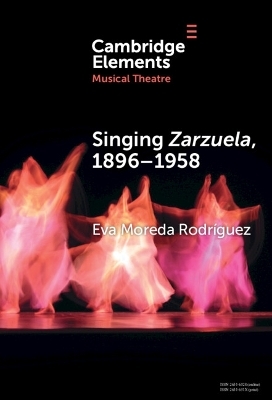
Singing Zarzuela, 1869–1958
Approaching Portamento and Musical Expression through Historical Recordings
Seiten
2024
Cambridge University Press (Verlag)
978-1-009-47574-7 (ISBN)
Cambridge University Press (Verlag)
978-1-009-47574-7 (ISBN)
- Noch nicht erschienen (ca. Februar 2025)
- Versandkostenfrei
- Auch auf Rechnung
- Artikel merken
By focusing on portamento, this Element sets the foundations for a sensitive history of vocal performance practices in zarzuela. It tells us about the transformation of the expressive code of zarzuela. Other changes include the make-up of audiences, the discourses about the genre's connection, and the influence of other genres and languages.
In the last few years, digitizations and reissues of historical recordings of Spanish zarzuela - from wax cylinders in the 1890s to long-play records in the 1950s - have revealed a range of contrasting vocal performance styles. By focusing on portamento, this Element sets the foundations for a contextually sensitive history of vocal performance practices in zarzuela. It takes stock of technological changes and shifts in commercial strategies and listening habits to reveal what the recorded evidence tells us about the historical development of portamento practices and considers how these findings can allow us to reconstruct the expressive code of zarzuela as it was performed in the late nineteenth century and how it transformed itself throughout the next half century. These transformations are contextualized alongside other changes, including the make-up of audiences, the discourses about the genre's connection to national identity and the influence of other musical-theatrical genres and languages.
In the last few years, digitizations and reissues of historical recordings of Spanish zarzuela - from wax cylinders in the 1890s to long-play records in the 1950s - have revealed a range of contrasting vocal performance styles. By focusing on portamento, this Element sets the foundations for a contextually sensitive history of vocal performance practices in zarzuela. It takes stock of technological changes and shifts in commercial strategies and listening habits to reveal what the recorded evidence tells us about the historical development of portamento practices and considers how these findings can allow us to reconstruct the expressive code of zarzuela as it was performed in the late nineteenth century and how it transformed itself throughout the next half century. These transformations are contextualized alongside other changes, including the make-up of audiences, the discourses about the genre's connection to national identity and the influence of other musical-theatrical genres and languages.
1. Introduction; 2. Interpreting portamento in zarzuela recordings; 3. Zarzuela on wax cylinders, 1896–1905; 4. Zarzuela on 78rpm discs, 1899–1924; 5. Electrical recording takes over, 1925–1939; 6. Zarzuela on long-play (LP) records, 1939–1958; 7. Conclusion; Reference.
| Erscheint lt. Verlag | 28.2.2025 |
|---|---|
| Reihe/Serie | Elements in Musical Theatre |
| Zusatzinfo | Worked examples or Exercises |
| Verlagsort | Cambridge |
| Sprache | englisch |
| Themenwelt | Kunst / Musik / Theater ► Musik ► Klassik / Oper / Musical |
| ISBN-10 | 1-009-47574-6 / 1009475746 |
| ISBN-13 | 978-1-009-47574-7 / 9781009475747 |
| Zustand | Neuware |
| Haben Sie eine Frage zum Produkt? |
Mehr entdecken
aus dem Bereich
aus dem Bereich
wie wir unsere Musikkultur retten
Buch | Hardcover (2023)
Frankfurter Allgemeine Buch (Verlag)
CHF 38,90


